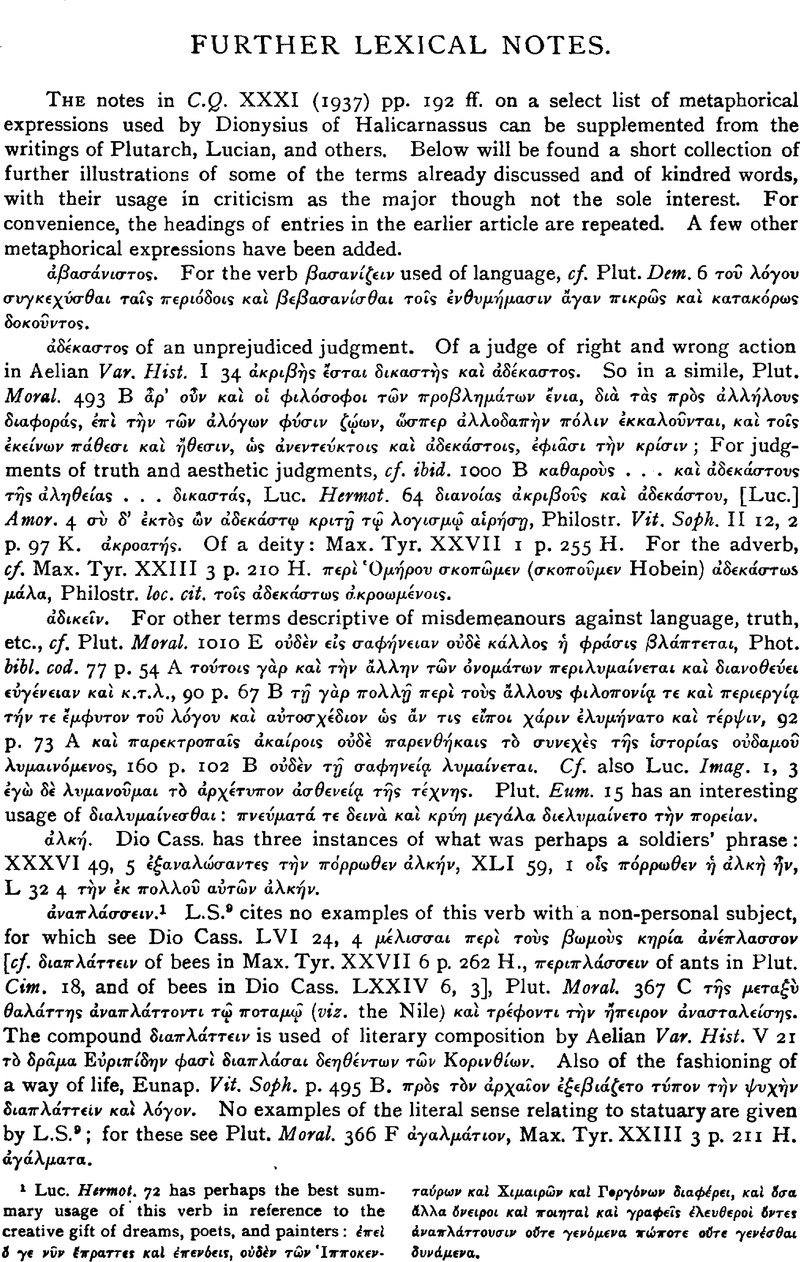No CrossRef data available.
Article contents
Further Lexical Notes
Published online by Cambridge University Press: 11 February 2009
Abstract

- Type
- Other
- Information
- Copyright
- Copyright © The Classical Association 1938
References
page 109 note 1 Luc, . Hermot. 72 has perhaps the best summary usage of this verb in reference to the creative gift of dreams, poets, and painters: πε γε ἓπραττες καІ πενόεις ούδν τν Ιπποκενταύρων κα Χιμαιρν κα Γοργόνων διαϕέρει κα ὃσα ἃλλα ὅνειροι κα ποιητα κα γραϕεῖς έλευθεροί ὅντες άναπλάττουσιν οὅτε γενόμενα πώποτε οὅτε γενέσθαι δυνάμεναGoogle Scholar.
page 110 note 1 Cousin, J., Études sur Quintilien Vol.IIpp. 42fGoogle Scholar.
page 110 note 2 In Rabe, Prol. Syll. p. 393Google Scholar it is asserted that the term νθηρς is a metaphor drawn from the human body: οὓτως οἱ ρϰαῖο ι γ τν ἰν γνωρΖοντες δροὐς κα ἰσϰνοὺς κα νθηροὺς ταὺς λόγους κάλεσαν κ τν νθρωπινν μορϕν τ νόματα θέμενοι.
page 110 note 3 Luc, . Heracl. 4Google Scholar recalls Homer in the words οὓτω γ τοι κα το Νστορος ὑmu;ῖν πορρεῖ κ τς γλώττης τ μλι, κα οἱ γορηταἰ τν Τρώωτ τν ὃπα τν λειριεσσαν ϕισιν εὐανθη τινα. λερια γρ καλεῖται, εἴ γε μμνημαι, τ ἂνθη.
page 111 note 1 In the contrast of αὐχμηρς with εὐανθς and νθηρς, dulness of colour (cf. αὐϰμώδης in Theophr, . de Lapid. 6Google Scholar, 37) may be part of the idea suggested, e.g. in Plut, . Moral. 500Google Scholar CD μν οὖν Αἰσώπειος λώπηΞ περ ποικιλας δικαΞομνη πρς τν πρδαλιν, ὡς κενη τ σμα κα τν έπιϕνειαν ύανθε κα κατάστικτον πεδείξατο. τῇ δ ἦν τ Ξανθν αὐϰμηρν καἰ οὐϰ δὺ προσιδεῖν, κ.τ.λ.
page 112 note 1 The mythological association of Aphrodite with Peitho and the Charites reappears in the language of criticism.
page 112 note 2 Geigenmüller, P., Quaestiones Dionysianae de Vocabulis Artis Criticae, P. 52Google Scholar.
page 113 note 1 This superlative-form is not mentioned by L.S.9
page 113 note 2 With these exx.may perhaps be grouped the use of the adverb in plut, . Moral. 616Google Scholar E τν πηλν πονιѰαμνους τν ποδς λαϕρς κα ϕελς παρπτον λλλοις συμϕρεσθαι (ibid. F there appears the phrase τϕως κα ϕελς κατακλνεσθαι μετ' λλλων).
page 114 note 1 Add also to L.S.9 the rhetorical use of εὐκαμπεῖς. εὐκαμπς in Max. Tyr. XXXI 3 p. 300 H. περιδοι
page 115 note 1 For Lucian's reminiscence of Homeric phrases, see p. no, n. 3 above.


